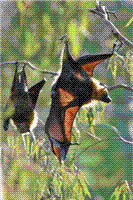Family
PteropodidaeGenus
PteropusSpecies
poliocephalus
Threats/Control Methods - Regional
Ongoing habitat clearing, especially in the coastal areas of NSW is leading to the decline of this species, due to a loss of suitable foraging and roosting areas. Unregulated culling by orchardists is also a major threat. Currently the only method of controlling this species as a fruit-eating pest is to use full crop netting. Trials are now underway to find other effective deterrents.
Threats/Control Methods - Local
Mature flowering eucalypts are being replaced with introduced tree species. The health of urban animals is also threatened by the build-up of lead in their systems, especially to lactating females.
Local/Urban Actions
Ongoing research is underway at the ANU regarding the needs of this species. The NSW National Parks and Wildlife service is responsible for conservation of this species, defining landuses and identifying and protecting habitat areas. Yards with areas of eucalypt trees are more likely to provide a short term roost and food tree for the Grey-headed Flying-fox.
Common name/s
Grey-headed Fruit-bat
Distinguishing Features
This species is the largest of the Australian fruit bats at about 25cm in length. It is very dark brown coloured except for its grey head and the rusty-red patch around the neck.
Species Call
A highly sophisticated combination of over 20 different situation-specific calls.
Similar Species
The Little Red Flying-fox (Pteropus scapulatus ) is lighter coloured and slightly smaller.
Distribution
This species is found from the coast of central QLD down to the west coast of VIC. They are rarely found more than 150km inland.
Country of Origin
Australia
Survey Techniques
Night searches and calls
Conservation (Pet/Pest) Status - National
Listed under the EPBC Act 1999 as Vulnerable, as numbers declined by 30% in the ten years after a 1989 study. They are also considered a pest to some commercial orchards, and limited licences to shoot are still issued while alternate non-lethal control methods are found.
Conservation (Pet/Pest) Status - Regional
Uncommon
LSCCES Population
Exact population numbers are very difficult to establish.
Associated vegetation community
This species inhabits eucalypt forest, rainforest and mangrove areas with large trees.
Limiting Resources
The size of the Flying-fox camps are directly related to the availability of their preferred food species. These food trees must be abundant and well spaced across large regions. Native forests and reserves are used, but unable to support the needs of a population in the long term.
Breeding
The breeding pattern is fixed each year. After mating, females move off into their own camp to produce one offspring in October. The female carries around the young animals for their first four to five weeks. After this time the female leaves her young behind during her nightly flight, locating her offspring by its unique odour. The mother may abandon her young in early summer if food sources are scarce.
Behaviour
This species is very social, roosting in large camps in either a permanent or seasonal location. They communicate with one another using 20 different calls, which can be heard by the human ear, inducing different behavioural responses from the bats around them. They use sight to navigate and their sense of smell to detect food.
Functional Group
Food Species
The Grey-headed Flying-fox eats the blossoms and nectar of eucalypts, native fruits and the Lillipillies. Although it is known to eat cultivated fruits from private and commercial orchards, this is only when their preferred food sources are scarce.
Predators
Many people consider this species to be a nuisance and culling has been a widespread practise for many years.
Interesting Fact
Luckily for the survival of this species, they do very well in captivity, breeding freely when ample suitable food is available.
References - (reader suitability of references, P=Primary teachers, S=Secondary students, T=Tertiary students and researchers)
Books:Strahan, R. (ed.) 1995. The Mammals of Australia. Australian Museum Trust/Reed Books. Chatswood NSW. P, S, T
Online Publications: Commonwealth of Australia. 2003. EPBC Act: Administrative Guidelines on Significance- Supplement for the Grey-headed Flying-fox. Department of Environment and Heritage. [online]. Available at:http://www.environment.gov.au/epbc/publications/greyheadedflyingfox/pubs/grey-headed-flying-fox-guidelines.pdf S, T
Environment Australia. 1999. The Action Plan for Australian Bats. Department of the Environment and Water Resources. Canberra. [online]. Available at: http://www.environment.gov.au/biodiversity/threatened/publications/action/bats/13.html S, T
Tidemann, C., Roscoe, T. and Mitchell, B. 2006. Mammals of the Lower Sullivans Creek Catchment, Canberra ACT. Prepared for the Life in the Suburbs project using data from the Lower Sullivans Creek Catchment Ecological Survey (LSCCES). Australian National University. Canberra. [online]. Available at: http://www.lifeinthesuburbs.com.au/category.php?id=65 S, T
Researcher: Naomi Hogan

 Top
Top Top
Top